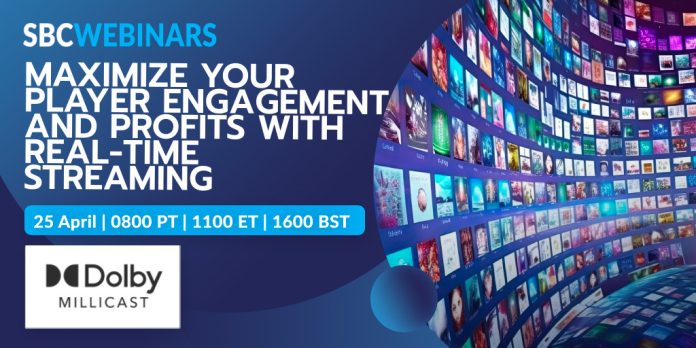Register to watch the full webinar by clicking here.
For gaming providers, connection with the audience is key. Without a stellar live and interactive user experience, brands risk being left behind in today’s saturated digital marketplace.
So, how can operators ensure they are giving their players what they want in real-time?
SBC Webinars recently hosted a webinar to answer that question, titled Maximize Your Player Engagement And Profits With Real-Time Streaming.
Dolby Millicast‘s Director of Product Strategy Ryan Jespersen and Sr. Product Marketing Manager Rose Power discussed how real-time streaming can power immersive social experiences for players and ultimately boost operators’ revenue.
Millicast, which was purchased by renowned technology company Dolby two years ago, is a platform that allows streamers to provide ultra-high-quality video to large-scale audiences with a delay of just half a second.
Jesperson noted that the technology is built on three pillars: creating immersion, interaction and social engagement.
Seamless streaming the name of the game
Ultra-low-latency streaming’s place in the world of events broadcasting has been evident for years, but the caliber of livestreaming has become an integral component of the modern gaming and betting experience.
“How do you maximize player engagement?” asked Jespersen. “How can you create the interactivity that keeps them engaged?”
The issue of minimizing video delays is paramount. Whether it’s live sports betting or live casino, ensuring consumers can stay up to the second is vital for maximizing customer satisfaction. In traditional streaming, there is a delay of usually five to 15 seconds; a lag that can be hugely detrimental to an in-play bettor.
Jespersen used horse racing as a pertinent example.
“Because the technology is so fast, you can actually keep the betting window open right until the gate happens or even enable a watch-and-wager use wherein users can hedge bets by being able to change horse after the first post,” he noted.
He cited the case of a Dolby Millicast customer with a big footprint in U.S. horse racing.
“They had a latency of 10 to 15 seconds. They mentioned that if they could keep the betting window open for even just another five seconds, they would increase their handle by 20%. This is a publicly-traded company doing hundreds of billions of dollars of revenue a year, so 20% is game-changing.”
That’s not just true of horse racing but of all wagering.
Live casino games continue to be a hugely popular and saturated market within North America. If live dealer offerings can have a latency of just a second or less, the number of hands per hour can be increased and, with it, operators’ total handle.
With great interactivity comes great power, for both the provider and the player.
One advantage that online casino streams offer over the traditional in-person table games experience is that technology can greatly increase the field of vision. This can be automated, wherein technology detects scene changes within a game and adds specific graphics or triggers reactions to create immersive interactivity.
Power emphasized that operators can also give power to the user.
“We can choose whatever angle users want to see and give the viewer a clean feed. They can actually interact and have control and rather than just having one choice of stream, they can go in and change the camera to select the view that’s optimal for them.”
Streaming video quality is key
While speed and interactivity are important, there are other considerations. The usefulness of a near-instant live sports or casino stream is greatly diminished if the quality of the picture doesn’t match.
Providing broadcast-quality streams is another essential piece of the puzzle. Power noted it’s critical not just for users to have a more enjoyable playing experience but also a fairer one.
“You can insert overlays in graphics so that you can see the numbers on the roulette wheel or the cards, the bets placed from the other players,” she said. “Imagine if you’re playing this game and the video is choppy and blurry, you can’t see all those things clearly. Suddenly, it becomes a very irritating and even unfair player experience and it’s pretty much a guarantee that your players won’t return.”
Capturing the streaming audience
At its core, the confluence of livestreaming and betting is all about increasing interactivity.
Jespersen suggested that nobody has entirely “cracked the code” to creating an entirely gamified ecosystem around live sports broadcasts. But we’re certainly walking down that path, with live odds updates and the ability to place bets now prominent in many sports broadcasts.
In one recent high-profile example, Sportradar and the NBA announced last month that NBA League Pass viewers will be able to opt in to track live odds changes and select a variety of in-play bets from the league’s sportsbook partners directly within the live streaming platform.
It’s an evolution that Jespersen only sees becoming more ubiquitous.
“The primary viewing experience for sports in the next few years, especially in the United States and Canada because of the regulation in the last couple of years, is going to be inside a betting app,” he said.
Offering high-quality, low-latency streams with a high level of direct betting and gaming interactivity is one thing. Building that out by offering other tied-in revenue streams, such as e-commerce, marketing, or free-to-play games, only adds to an operator’s arsenal.
“Why not create other revenue sources that aren’t just betting?” asks Jespersen. “This what FanDuel and DraftKings did that was so smart. They were going after gamification and fantasy sports and when it finally came to regulation, they had all the products ready to go. This is why you see them dominating the sports betting space; because they add so much value around gamification and creating interactivity and content to engage with players.”
That can be particularly challenging when it comes to the seasonality of sports. An NFL season is just four months long, leaving two-thirds of a year when, draft and preseason excitement aside, football fans and bettors can lie dormant if not consistently engaged.
Capturing both active fans and passive viewers during those off-peak times is “one of the most powerful ways” providers can boost engagement and increase revenue, said Power. She cited a Deloitte study that found that year-round fan engagement leads to a 52% increase in ticket and merchandise sales.
That’s not only a huge boon for sports leagues and teams but also represents a profitable opportunity for sportsbooks and gaming operators to keep up the mid-season pace.
“Eliminating this offseason concept and engaging fans year round is so smart for pulling more fans into the sales funnel,” added Power.
Livestreaming and in-play betting is a big show with a hungry audience. Knowing how to provide the most seamless and interactive experience possible can be a key differentiator for those in the industry looking to stand out from the crowd.














